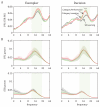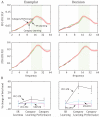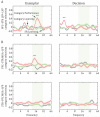Increases in functional connectivity between prefrontal cortex and striatum during category learning
- PMID: 24930701
- PMCID: PMC4098789
- DOI: 10.1016/j.neuron.2014.05.005
Increases in functional connectivity between prefrontal cortex and striatum during category learning
Abstract
Functional connectivity between the prefrontal cortex (PFC) and striatum (STR) is thought critical for cognition and has been linked to conditions like autism and schizophrenia. We recorded from multiple electrodes in PFC and STR while monkeys acquired new categories. Category learning was accompanied by an increase in beta band synchronization of LFPs between, but not within, the PFC and STR. After learning, different pairs of PFC-STR electrodes showed stronger synchrony for one or the other category, suggesting category-specific functional circuits. This category-specific synchrony was also seen between PFC spikes and STR LFPs, but not the reverse, reflecting the direct monosynaptic connections from the PFC to STR. However, causal connectivity analyses suggested that the polysynaptic connections from STR to the PFC exerted a stronger overall influence. This supports models positing that the basal ganglia "train" the PFC. Category learning may depend on the formation of functional circuits between the PFC and STR.
Copyright © 2014 Elsevier Inc. All rights reserved.
Figures






References
-
- Ashby FG, Ennis JM, Spiering BJ. A neurobiological theory of automaticity in perceptual categorization. Psychol Rev. 2007;114:632–656. - PubMed
Publication types
MeSH terms
Grants and funding
LinkOut - more resources
Full Text Sources
Other Literature Sources
Miscellaneous

